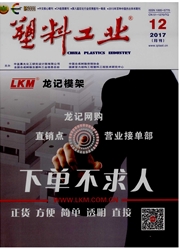

 中文摘要:
中文摘要:
对杨木木粉进行酸碱处理后得到纯纤维素溶液,之后通过超声和研磨均质两种方法对纤维素进行机械开纤处理,得到两种不同尺寸的纤维素纤丝溶液。通过场发射扫描电镜观察,超声后的纤维素纤丝的直径分布在200—250nm,研磨均质后的纤维素纤丝直径主要分布在20-100nm。由于纤维素纤维直径的细化,研磨均质后的纯纤维素薄膜的透光率高于超声后的,并且比普通打印纸提高近四倍。浸渍环氧树脂的复合薄膜也随着纤维素纳米纤丝直径减小,透光率提高,研磨均质后的复合薄膜透光率相比纯环氧树脂,仅损失3%。这表明研磨均质的纤维素纳米纤丝增强环氧树脂薄膜可以作为高透明性材料使用。
 英文摘要:
英文摘要:
The poplar wood powder was treated to be the cellulose solution by the acid and alkali agents, then the ultrasound and grind and homogenization methods were used to separate the wood fiber to cellulose nanofibers (CNFs) in different sizes. The FE-SEM images revealed that the diameter distribution of CNFs by the ultrasound was in 200 -250 nm, and that by the grind and homogenization was in 20 -100 nm. Because of the decrease of the CNFs' diameter, the light transmittance of the CNFs film by the grind and homogenization was higher than that by the ultrasound, and it was nearly 4 times compared with that of the normal paper. The light transmittance of the CNFs-reinforced epoxy composite was increased when the CNFs' diameter decreased, and the light transmittance was just lost 3% after the CNFs film by the grind and homogenization dipped into the epoxy resin. These data showed that the CNFs-reinforced epoxy composite can used to be the high transparency materials.
 同期刊论文项目
同期刊论文项目
 同项目期刊论文
同项目期刊论文
 Strong and optically transparent biocomposites reinforced with cellulose nanofibers isolated from pe
Strong and optically transparent biocomposites reinforced with cellulose nanofibers isolated from pe Three kinds of charcoal powder reinforced ultra-high molecular weight polyethylene composites with e
Three kinds of charcoal powder reinforced ultra-high molecular weight polyethylene composites with e Foldable and free-standing 3D network electrodes based on cellulose nanofibers, carbon nanotubes and
Foldable and free-standing 3D network electrodes based on cellulose nanofibers, carbon nanotubes and Optical and flexible α-chitin nanofibers reinforced poly(vinyl alcohol) (PVA) composite film: Fabric
Optical and flexible α-chitin nanofibers reinforced poly(vinyl alcohol) (PVA) composite film: Fabric High-performance nanocomposite films: reinforced with chitosan nanofiber extracted from prawn shells
High-performance nanocomposite films: reinforced with chitosan nanofiber extracted from prawn shells The dynamical viscoelasticity and tensile property of new highly filled charcoal powder/ultra-high m
The dynamical viscoelasticity and tensile property of new highly filled charcoal powder/ultra-high m Dissolution and gelation of alpha-chitin nanofibers using a simple NaOH treatment at low temperature
Dissolution and gelation of alpha-chitin nanofibers using a simple NaOH treatment at low temperature Carbon fiber reinforced highly filled charcoal powder/ultra high molecular weight polyethylene compo
Carbon fiber reinforced highly filled charcoal powder/ultra high molecular weight polyethylene compo Preparation of Ultralong Cellulose Nanofibers and Optically Transparent Nanopapers Derived from Wast
Preparation of Ultralong Cellulose Nanofibers and Optically Transparent Nanopapers Derived from Wast Flexible highly specific capacitance aerogel electrodes based on cellulose nanofibers, carbon nanotu
Flexible highly specific capacitance aerogel electrodes based on cellulose nanofibers, carbon nanotu A three-dimensionally chitin nanofiber/carbon nanotube hydrogel network for foldable conductive pape
A three-dimensionally chitin nanofiber/carbon nanotube hydrogel network for foldable conductive pape Properties of polymethyl methacrylate-based nanocomposites: Reinforced with ultra-long chitin nanofi
Properties of polymethyl methacrylate-based nanocomposites: Reinforced with ultra-long chitin nanofi Preparation and Properties of Optically Transparent Chitin Nanofibers Sheet by Different Simple Mech
Preparation and Properties of Optically Transparent Chitin Nanofibers Sheet by Different Simple Mech 期刊信息
期刊信息
